Last-Minute NYC Holiday Gift Guide 🎁
We’ve created a holiday gift guide with presents for the intrepid New Yorker that should arrive just in time—


Just an hour flight time from New York City, Cleveland is in the midst of an art-fueled urban renaissance, building upon its long architectural and cultural heritage, while embracing the small scale industries, creative culinary scene, and high tech companies that are driving the new economy. Cleveland is after all a city built by the likes of the Rockefellers – but also with a long manufacturing and industrial history. For those seeking to revel in what Brooklyn is losing, Cleveland is transforming long fallow zones into dynamic places to live and work from the community up.
From the stunning to quirky, here are ten sites not to miss on a visit to Cleveland.
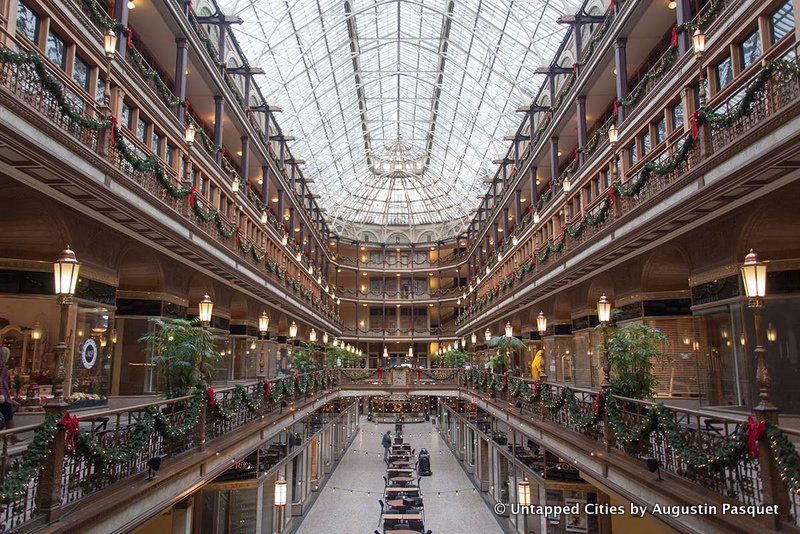
There isn’t much in America that looks like this anymore and the Arcade Cleveland captures that turn of the century sense of wonder. The arcade, financed by Cleveland industrialists like John D. Rockefeller, Rockefeller’s partner, Steven V. Harkness, and Louis Severance, another founding member of Standard Oil, was built at a cost of $875,000 in 1890 (that’s about $23,7 million in 2016 dollars). The arcade was intended as a mercantile center, said to be the first indoor shopping center in the country, and used predominantly as office and retail space. Like an arcade in the true sense, it connects between Euclid and Superior Avenue.
The Arcade Cleveland was built atop what was a sandy Prehistoric lake and the grand staircase follows the original natural topography, Tom Yablonsky, Executive Director of the Downtown Cleveland Alliance shows us. The most stunning architectural features are the glass roof and the long interior atrium space, at 290 feet long, designed to allow in a sumptuous amount of natural light. The only arcade in the world that exceeds it in length is the Galleria Vittorio Emanuele II in Milan, Italy, one of its architectural inspirations. Despite landmark designation, the first in Cleveland to receive National Landmark status and just the 9th in the country, the Arcade deteriorated over the years. A $60 million restoration took place in 2001 with the Hyatt Development Corporation stepping in as the major anchor tenant.
The Arcade Cleveland is the must stunning, but there are several more worthy of a visit just nearby. The 5th Street Arcades combines two historic arcades: The Colonial Arcade and the Euclid Arcade. And don’t miss the cluster of beautiful, restored theaters in Playhouse Square, considered the second largest theater complex after Lincoln Center in New York City.
The Cleveland Arcade is located on East 4th Street, between Euclid and Superior Avenues.
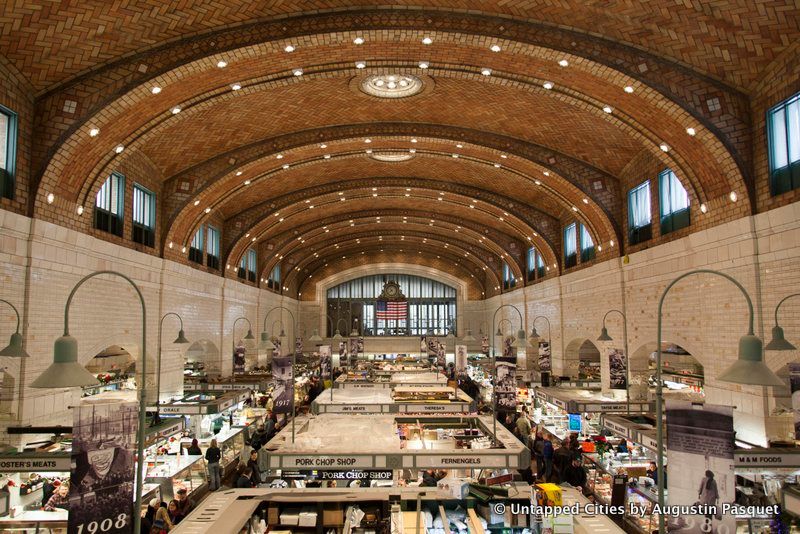
For a New Yorker who steps inside West Side Market, the vaulted ceiling will seem very familiar. That’s because the tiled ceiling is by Guastavino, the prolific immigrant craftsmen who produced the tiling at Grand Central Terminal, Ellis Island, the Municipal Building downtown and much more. Here, the ceiling is 44 feet high, crowning a market space 241 feet long. Construction began on the market in 1908 and was completed in 1912, making the structure, which retains its original function, over a 100 years old. Just like when it opened, today, the market offers over 100 booths selling fresh fruits, vegetables, meats, dairy and a plethora of ethnic foods at affordable prices.
The West Side Market is located at 1979 West 25th St. in the Ohio City neighborhood.
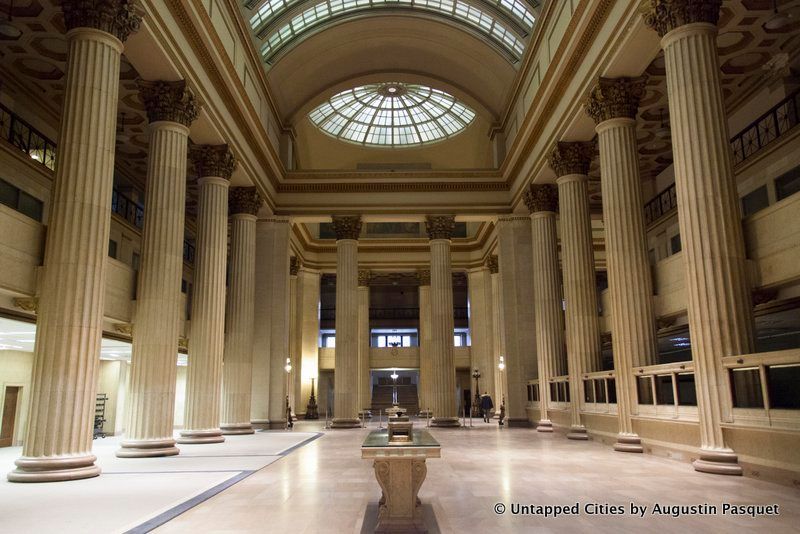
One sign of the scale of development that’s taking place in Cleveland is the conversion of the 925 Euclid Building, one of the more ambitious projects in the city. The building formerly known as the Huntington Building was built in 1924 as the Union Trust Building, the second largest horizontal building in the country at the time, Tom Yablonsky says. And hidden behind the entrance foyer is the largest bank lobby in the world, closed to the public since 2012 when Huntington Bank moved out. Not only is the scale of the bank space just massive, the L-shaped lobby is designed in the style of a Greek temple. Massive Corinthian columns line the three-story space with colorful murals by Jules Guerin, who also painted the murals inside the Lincoln Memorial in Washington D.C.
A Cleveland developer plans to spend somewhere around $280 million to convert it into a mixed-use complex, including a Hilton Curio hotel, conference space, apartments, retail, office space, and restaurants and rooftop club. Construction is expected to be completed at the end of this year or early 2018.
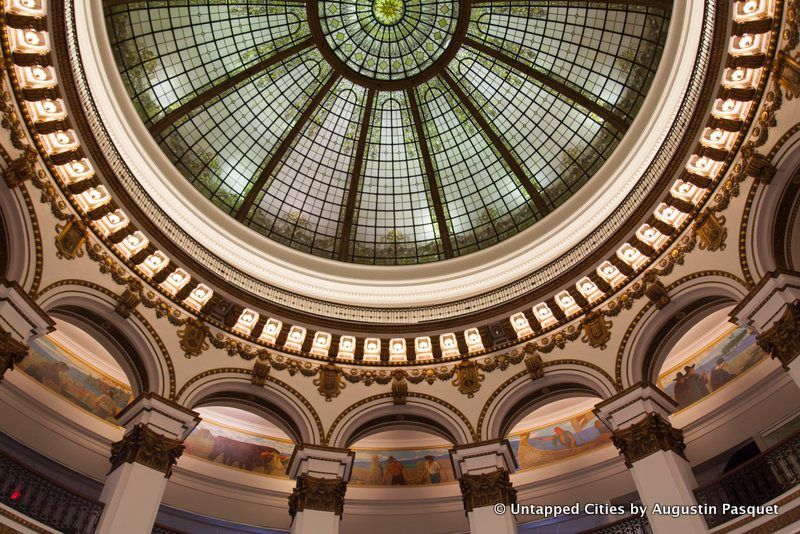
Just across the street from 925 Euclid is the stunning Cleveland Trust Rotunda Building, opened in 1908. The Atrium is home to Heinen’s Fine Foods and is probably the most architecturally inspiring places to have a coffee or pick up groceries in the city. Architect George B. Post, who was extremely prolific in New York City, designed this stately building with a Tiffany-glass dome.
When visiting, look out for the brass crest on the floor in the middle of the atrium below the dome that says “The Cleveland Trust Company,” the murals by Francis David Millet titled “The Development of Civilization in America” and the sculptures on the exterior pediment. Millet perished in the Titanic, his career cut short by the accident.
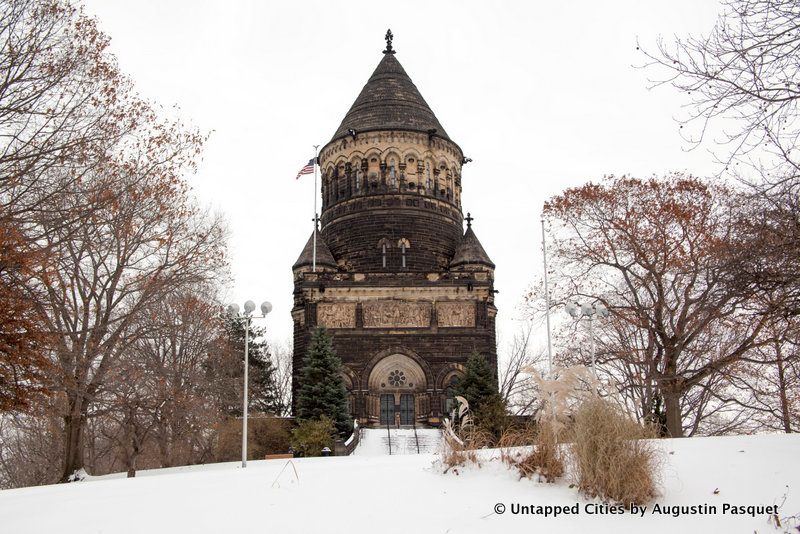
With so many notable people who hail from Cleveland, it’s not surprising they would plan impressive final resting places for themselves. The cemetery of choice for the Gilded Age industrialists was Lake View Cemetery, still an active cemetery open to all. The most famous place inside Lake View is the burial site and memorial of assassinated President James A. Garfield (above). Inside there’s a gold, mosaic dome with motifs that illustrate Garfield’s life and the history of the United States. Katharine Goss, President and CEO of Lake View Cemetery, tells us that since 2015, a restoration effort has been underway to stabilize the structure, prevent water leakage, and strengthen the building.
But among those also buried in Lake View include John D. Rockefeller, Elliott Ness, Alan Freed (the radio DJ credited with popularizing rock ‘n roll), Henry Sherwin, founder of Sherwin Williams, and a host of Cleveland society. Also don’t miss the Jeptha A. Wade Memorial Chapel, a neoclassical standalone structure on the lakeside with a beautiful interior of Tiffany glass.
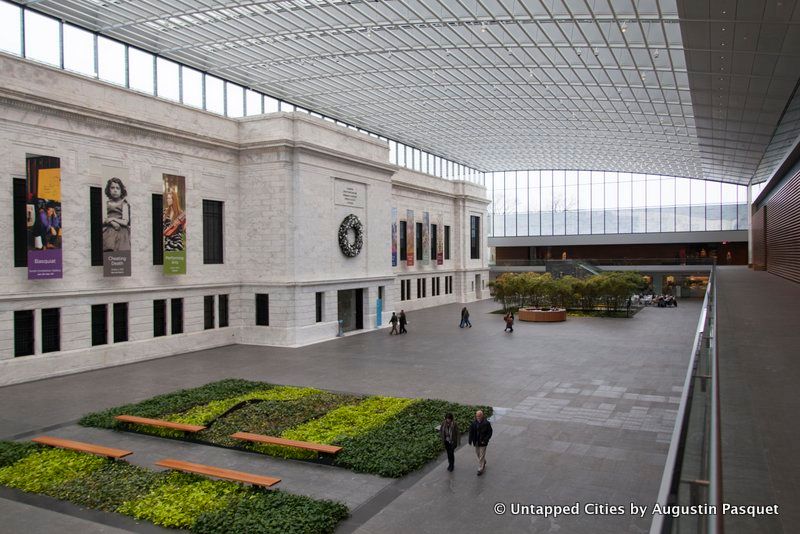
The Cleveland Museum of Art‘s ambitious $350 million renovation over the course of more than a decade joins together the original 1916 Beaux-arts museum building and a 1971 education wing designed by Marcel Breuer with a 39,000 square foot, 66-foot high glass Atrium by architect Rafael Viñoly, recently more famous for the New York City skyscraper 432 Park Avenue.
For the full experience grab a lunch at Provenance, the restaurant that is located just off the atrium with a view of Wade Park and the Fine Arts Garden and then take in the galleries. Then, walk around the stately historic homes of the University Circle Hub, an area undergoing an urban planning renaissance of its own, with an aim to better connect and densify the arts, education and medical activities in this hub. There’s a new bike share system with mixed use development that fills in previously empty parking lots, and art beautification projects (a whimsical one on the transformer boxes on the street). Elise Yablonsky, the Planning Director for University Circle tells us that the way finding project known as Circlewalk “tells the story of the people, places and institutions” of the neighborhood.
The Cleveland Museum of Art also has an outpost, The Transformer Station, located in a former substation of the Cleveland Railway Company in Ohio City, not far from the West Side Market. The Transformer Station focuses on contemporary art and photo-based art and on our visit was showcasing the impressive works of those on the Museum staff.
The Cleveland Museum of Art is located at 11150 East Boulevard, Cleveland, 44106
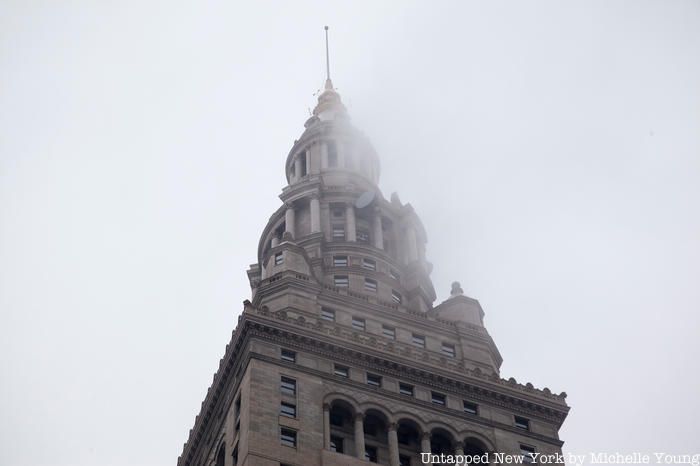
Unlike many of the observation decks in New York City that have been removed from public access, Cleveland’s Terminal Tower re-opened its 42nd floor observation deck after renovation. The skyscraper is part of Tower City Center, a sprawling development built above rail yards using air rights. The original plans drawn up by O.P and M. J. Van Sweringen, the railroad magnate brothers, for a 17-acre complex that would be connected together. In addition to the active train station that serviced the Baltimore and Ohio, New York Central and Nickel Plate Road railroad lines, there was a post office, a department store, and office towers, including the tallest – Terminal Tower, at 52 stories.
In 1977, the train service ended at the station due to lack of popularity of the route and the area was transformed into an indoor shopping mall. The original post office building at Terminal City closed in 1982 and was converted into an office building.
The panorama you take in provides a clear overview of the Cleveland landscape –the downtown Historic Gateway District, the industrial bridges and dockyards, and the manufacturing plants.A glass case on the observation floor contains vintage paraphernalia, with a brochure that claims by going up, “You can see more in a glance than you can see in a week of sight-seeing,” and that a trip to Cleveland would not be complete without a visit here. We would have to agree.
Inside the public square, you can also visit inside the Soldiers and Sailors Monument, next to which Abraham Lincoln’s body was shown for public viewing in 1865. The Monument has been restored and can be visited Tuesday through Saturday.
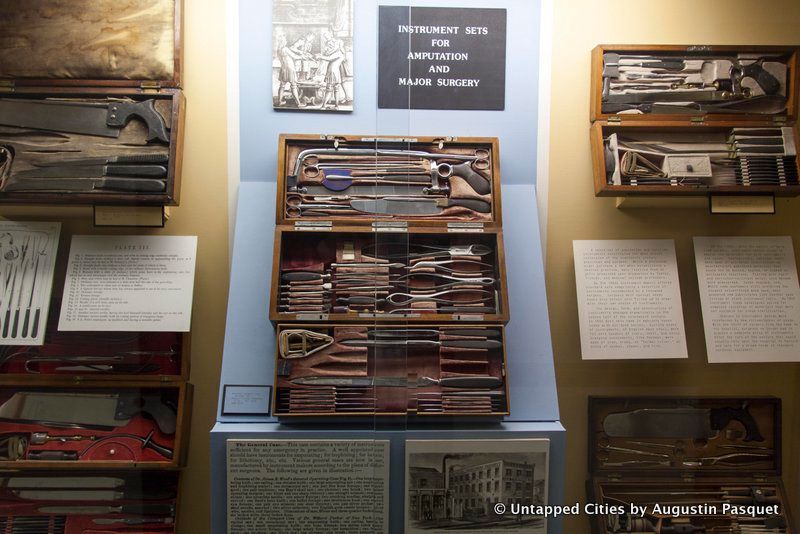
One of the quirkiest museums in America is located inside Case Western University in the University Circle area. The Dittrick Museum of Medical History has everything for those fascinated in this kind of thing – Civil War-era amputating kits (so many, they are displayed in a standing glass exhibition case), the world’s largest collection of historic contraceptives, a 1555 edition of an influential book on human anatomy, medical furniture, and more.
Each area of inquiry has a full range of artifacts: two cases of stethoscopes, one case of blood pressure monitors. There are early radiology machines, electrocardiograph machines, an iron lung machine. The contraceptive gallery shows much more than devices however, but traces the history of birth control societally and medicinally, including historical medical advice literature and mid-19th century toilets. The collection clearly shows the social and moral pendulum swing that has accompanied the subject of birth control in America.
Chief Curator James Edmonson tells us that later this year touch screens will arrive to the museum, though “it’s not that we want technology to overwhelm the real stuff that we have to see and enjoy, but we realized, you have to keep up with the trends or you’ll be left in the dust, so we got a grant from the National Endowment of the Humanities.”
The Dittrick Museum is featured in the book Medical Museums: Past, Present and Future. While you’re visiting, also don’t miss the home of the Cleveland Orchestra. There’s a ground level entrance on Euclid Avenue that was once an entry way for automobiles. Concertgoers were once dropped off directly inside the building.
The Dittrick Museum is located at 11000 Euclid Ave., Cleveland, 44106.
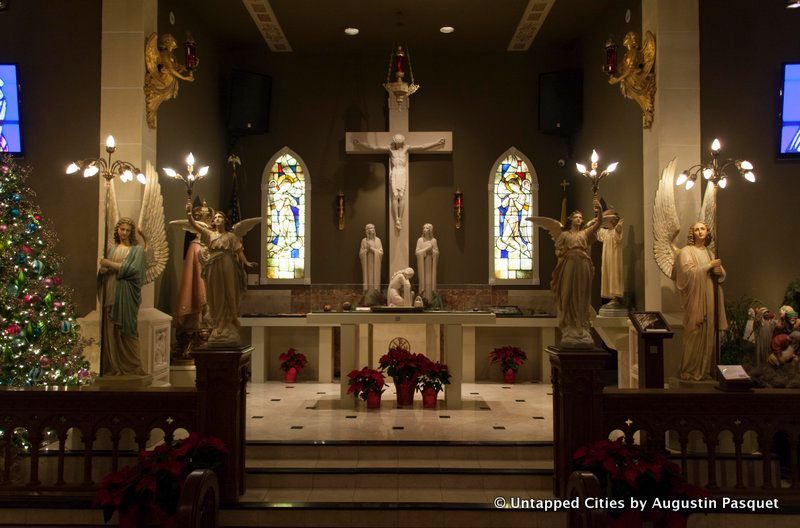
Another quirky spot in Cleveland is the Museum of Divine Statues, founded by Cleveland native Lou McClung. McClung painstakingly restores ecclesiastical statues, often from parishes that have closed. As McClung walks us around the museum in Lakewood, he explains that he started simply as a collector. But the multi-talented man is also a makeup entrepreneur and makeup artist, and applies his knowledge to the rehabilitation of the statues. His work has become so renown, statues have been shipped to him from across the country for restoration. “Through art, we use it to represent history,” McClung says, and has collected an impressive database of information about each of the statues which can be accessed via mobile devices in the museum.
Appropriately, the Museum of Divine Statues is located in a former church and the collection of statues that line the former nave includes a 19th century statue of St. Elizabeth of Hungary, the oldest in the mix. In the vestry rooms and altar of the former church are some of the quirkier things to look out for. One room has a collection of nearly 40 dolls dressed as nuns of different orders found in Cleveland. A display case shows the religious items carried by soldiers in World War I, often formed out of bullets and shrapnel.
McClung restores the statues in a room at the front entrance of the museum, viewable through a window from the outside.
The Museum of Divine Statues is located at 12905 Madison Avenue., Lakewood, 44107
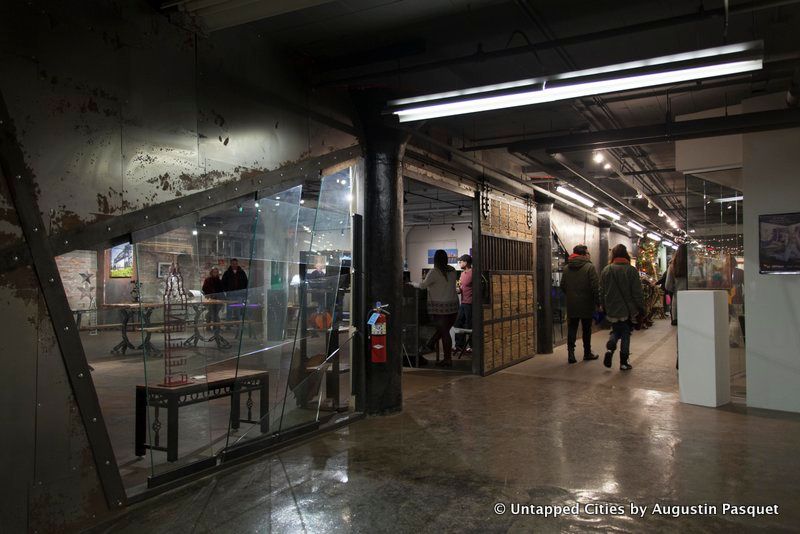
The 78th Street Studios is a 170,000 square foot hive of artist studios, galleries, recording studios, and performance spaces – defined by the owner and developer, Daniel Bush, as an “eclectic art maze.” He bought the building sixteen years ago and turned it into what is now northeast Ohio’s largest art and design complex. Every third Friday, there’s a Brooklyn-flea event of sorts, mixed with a gallery hop with wine and alcohol mixed in. There’s a black box stage tucked inside, its shows consistently sold out. We can only describe it as a hive, its residents thriving inside the readapted space making fruitful connections within, but heading outside for inspiration. The atmosphere is so communal that visitors accidentally wander into Bush’s office, filled with art, as he talks to us. He welcomes them to look around, but gently lets them know they’re in his office.
78th Street Studios is located at 1300 W. 78th St., Cleveland in the Gordon Square Arts District. This district, along with the Detroit Shoreway, is undergoing an interesting urban redevelopment, with storefronts occupied by small entrepreneurs, many who have come out of Cleveland Hustles, a “Shark Tank”-like program run by LeBron James. The commercial stretch and Italian neighborhood abut a lakeside factory edge that’s being transformed into artist studios, like 78th Street Studios, but also condo housing.
While this is an architectural guide, we know visitors have to eat. Here are the places we highly recommend:
Edwin’s Leadership and Restaurant Institute: This inspiring restaurant features fine French cuisine – some of the best we’ve had in the United States recently – staffed by formerly incarcerated adults who go through a six month training program, living and working in this Shaker Square learning the ins and outs of the culinary industry, working back of house as chefs, front of house as servers, managers and bartenders. The mission is to teach a skilled trade in hospitality to prepare these students for a successful transition into the world of business professionals. Edwin’s is founded by Brandon E. Chrostowski (the name of the institute and restaurant comes from his middle name) who took his brush with the law in Detroit and transformed it into a career in the culinary world that extends from New York’s Le Cirque to Paris’ Lucas Carton.
The Plum Café and Kitchen: Representing the creative freedom available to young chefs in Cleveland, The Plum Café and Kitchen offers an innovative take on locally sourced American cuisine paired with classic drinks and cocktails for lunch and dinner. Chef Brett Sawyer highlights the flavors of the season in his creative small plates that guests can savor in a modern and bright dining space. The former storefront manages to be both warm and minimalist at the same time, with soaring ceilings and brick details.
Provenance: As previously mentioned in the article, this restaurant inside the Cleveland Museum of Art led by Chef Doug Katz s a great spot to take a respite from your visit.
Next, read about the 10 most important architectural sites in downtown Los Angeles.
Subscribe to our newsletter